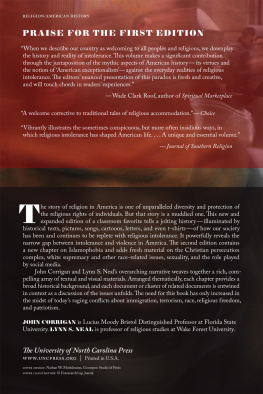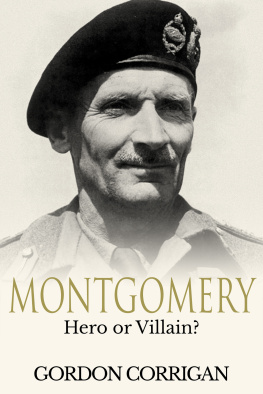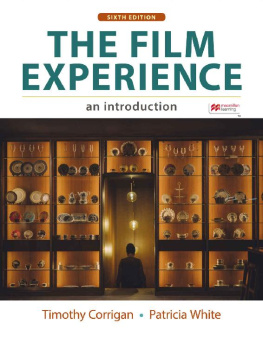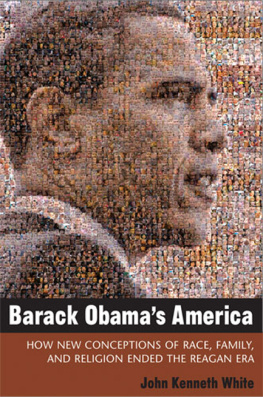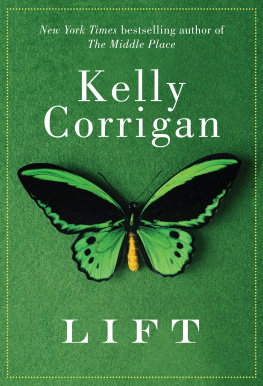John Corrigan - Religion in America
Here you can read online John Corrigan - Religion in America full text of the book (entire story) in english for free. Download pdf and epub, get meaning, cover and reviews about this ebook. year: 2018, publisher: Taylor and Francis, genre: Politics. Description of the work, (preface) as well as reviews are available. Best literature library LitArk.com created for fans of good reading and offers a wide selection of genres:
Romance novel
Science fiction
Adventure
Detective
Science
History
Home and family
Prose
Art
Politics
Computer
Non-fiction
Religion
Business
Children
Humor
Choose a favorite category and find really read worthwhile books. Enjoy immersion in the world of imagination, feel the emotions of the characters or learn something new for yourself, make an fascinating discovery.
- Book:Religion in America
- Author:
- Publisher:Taylor and Francis
- Genre:
- Year:2018
- Rating:3 / 5
- Favourites:Add to favourites
- Your mark:
- 60
- 1
- 2
- 3
- 4
- 5
Religion in America: summary, description and annotation
We offer to read an annotation, description, summary or preface (depends on what the author of the book "Religion in America" wrote himself). If you haven't found the necessary information about the book — write in the comments, we will try to find it.
Religion in America — read online for free the complete book (whole text) full work
Below is the text of the book, divided by pages. System saving the place of the last page read, allows you to conveniently read the book "Religion in America" online for free, without having to search again every time where you left off. Put a bookmark, and you can go to the page where you finished reading at any time.
Font size:
Interval:
Bookmark:
This comprehensive narrative account of religion in America from the sixteenth century through the present depicts the religious life of the American people within the context of American society. It addresses topics ranging from the European origins of American religious thought and the diversity of religion in America to the relation of nationhood with religious practice and the importance of race, ethnicity, and gender in American religious history. Split into four parts, this textbook covers:
- Religion in a Colonial Context, 14921789
- The New Nation, 17891865
- Years of Midpassage, 18651918
- Modern America, 1918Present
This new edition has been thoroughly updated to include further discussion of colonialism, religious minorities, space and empire, religious freedom, emotion, popular religion, sexuality, the ascent of the nones, Islamophobia, and the development of an American mission to the world.
With a detailed timeline, illustrations and maps throughout, and an accompanying companion website, Religion in America is the perfect introduction for students new to the study of this topic who wish to understand the key themes, places, and people who shaped the world as we know it today.
John Corrigan is Lucius Moody Bristol Distinguished Professor of Religion and Professor of History at Florida State University, USA.
NINTH EDITION
John Corrigan
Winthrop S. Hudson

Ninth edition published 2018
by Routledge
711 Third Avenue, New York, NY 10017
and by Routledge
2 Park Square, Milton Park, Abingdon, Oxon, OX14 4RN
Routledge is an imprint of the Taylor & Francis Group, an informa business
2018 Taylor & Francis
The right of John Corrigan and Winthrop S. Hudson to be identified as authors of this work has been asserted by them in accordance with sections 77 and 78 of the Copyright, Designs and Patents Act 1988.
All rights reserved. No part of this book may be reprinted or reproduced or utilised in any form or by any electronic, mechanical, or other means, now known or hereafter invented, including photocopying and recording, or in any information storage or retrieval system, without permission in writing from the publishers.
Trademark notice: Product or corporate names may be trademarks or registered trademarks, and are used only for identification and explanation without intent to infringe.
First edition published by Pearson Education 1992
Eighth edition published by Routledge 2010
Library of Congress Cataloging-in-Publication Data
Names: Corrigan, John, 1952 author. | Hudson,
Winthrop S. (Winthrop Still), 19112001, author.
Title: Religion in America / John Corrigan,
Winthrop S. Hudson.
Description: 9 [edition]. | New York : Routledge, 2018. |
Includes bibliographical references and index.
Identifiers: LCCN 2017042244 | ISBN 9780815392620
(hardback) | ISBN 9780815392606 (pbk.) |
ISBN 9781351190312 (ebook)
Subjects: LCSH: United StatesReligion.
Classification: LCC BL2525 .C695 2018 |
DDC 200.973dc23
LC record available at https://lccn.loc.gov/2017042244
ISBN: 978-0-8153-9262-0 (hbk)
ISBN: 978-0-8153-9260-6 (pbk)
ISBN: 978-1-351-19031-2 (ebk)
Typeset in Sabon
by Apex CoVantage, LLC
Visit the companion website: www.routledge.com/cw/corrigan
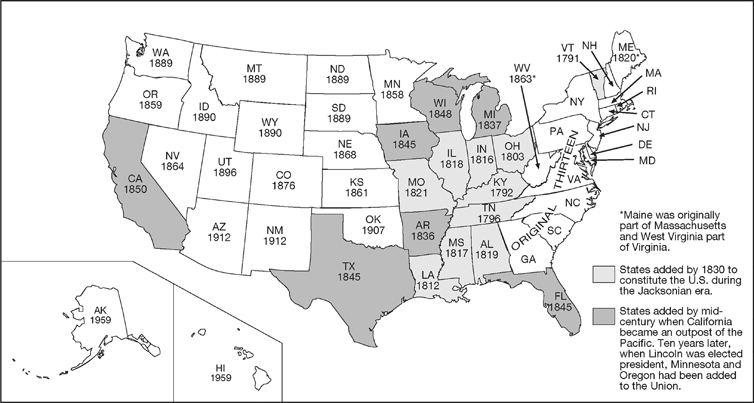
Expansion of the United States with dates when new states became part of the union.
PART I
Religion in a Colonial Context, 14921789
PART II
The New Nation, 17891865
PART III
Years of Midpassage, 18651918
PART IV
Modern America, 1918Present
This is a story about religion in America. But it is not the only story about religion in America. At certain points in the telling, it corresponds with other stories about people, places, and religious things. Sometimes, on the other hand, this story takes turns that distance it from those other stories. Like all other stories of a nations past, it is an intertwining of many threads of narrative. Here and there those threads are woven into a relatively sturdy, even fabric. In other places, the warp and woof are uneven, ragged, or fragile. History is complex, to some extent indeterminate, and is subject to constant revision. This history of the development of American religious life is, accordingly, a work in progress. A story changes with each telling, and this story is no different. In preparing Religion in America for a ninth edition, I have added several new sections, and have enlarged and detailed others. In this edition, I have focused especially on important themes and events in the wake of 9/11, which are discussed in a new . I have emphasized the emotional quality of religion in America, and cited examples of the range of emotions and the ways in which they are expressed. There is more here on religion and business, race and ethnicity, sexuality, and conservative politics. The claiming of space, and the construction of ideologies of space, together with the impulses to build empire, are more prominent here than in previous editions. The trajectories of Hispanic Catholicism and Native American cultures, which define the earliest histories of religion in America, are more perceptible in recent years and accordingly are discussed in greater detail.
Five overlapping contexts frame the story. First, religion is pictured in its relations with other aspects of American life. Religious traditions and communities exercise a profound influence on the formation of culture in America. Religion, in turn, is constantly being shaped by forces outside the church, synagogue, mosque, and meetinghouse. Some religion is itself outside the place of worship, constituted as part of personal or family religion, or limited to a small group of innovators who cultivate their piety outside institutional life. Such religion often represents an even more dynamic, ongoing negotiation between religious tradition and cultural change. Religion in America addresses religious life as a whole as it arises in the context of these reciprocal relationships.
Second, the Atlantic dimension forms a key part of the story. Although religions in America exhibit distinctive features, most religious persons practice devotions that bear the mark of a predominantly European background. After the initial migration of Europeans to America, the European influence was sustained in various ways and most conspicuously through waves of immigration. It is true as well that in the course of being translated to an American context, religion that originated in Europe was modified. In some cases the change was minimal, and in other cases the process of adaptation resulted in dramatic recastings of religious belief and practice. The influence from Africa likewise was profound. African traditional religions were blended with Christianity in the Americas, sometimes in stages that included a string of locations, from Africa (where Christian missionaries had begun working) to Caribbean islands, then to the American South, and then to other parts of the United States as blacks migrated in large numbers northward. Islam also came from Africa. The exchange between the United States and the Caribbean in the twentieth century was a lively back and forth process that was especially visible in relationships between large cities such as Miami, New York, New Orleans, and Chicago, and the islands of Cuba, Jamaica, Haiti, Puerto Rico, the Dominican Republic, and others. Though scholars generally refer to the Atlantic world in relation to the period 15001800, it is important that we see exchanges between Europe, the Americas, and Africa as ongoing. Communities formed through the large-scale immigration of Hispanics from Mexico and Latin America in the twenty-first century still bear some of the marks of the lively dissemination of culture (and especially the Spanish Catholic influence) that took place in an earlier period, in a colonial context characterized by European domination of indigenes. Hispanic Catholicism, not only in the southwest but virtually throughout the nation, has developed through a complex of influences, ranging from Spanish devotional practices and Native American religious life to well-established local traditions regarding the Virgin Mary and various saints and holy figures. The influences arising from Pacific immigration, while less visible than those from the Atlantic, have been significant in the development of Buddhism, Hinduism, Chinese and Japanese religions, and other religious communities that look to Asia for their leads. The majority of Asian immigrants, however, have been Christian.
Font size:
Interval:
Bookmark:
Similar books «Religion in America»
Look at similar books to Religion in America. We have selected literature similar in name and meaning in the hope of providing readers with more options to find new, interesting, not yet read works.
Discussion, reviews of the book Religion in America and just readers' own opinions. Leave your comments, write what you think about the work, its meaning or the main characters. Specify what exactly you liked and what you didn't like, and why you think so.


